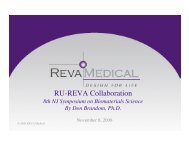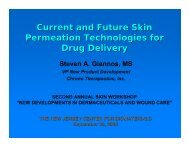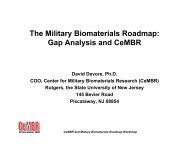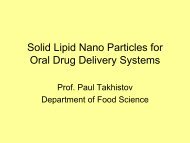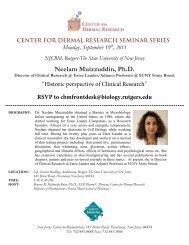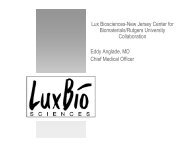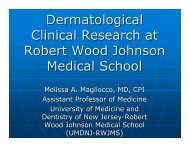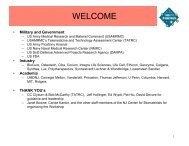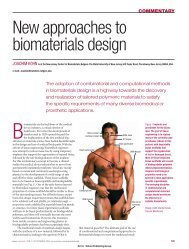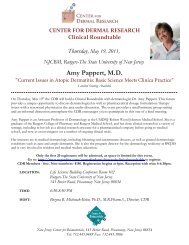Linda Griffith, PhD, Professor and Director of the MIT Biotech ...
Linda Griffith, PhD, Professor and Director of the MIT Biotech ...
Linda Griffith, PhD, Professor and Director of the MIT Biotech ...
Create successful ePaper yourself
Turn your PDF publications into a flip-book with our unique Google optimized e-Paper software.
Integration <strong>of</strong> Molecular <strong>and</strong> Macroscopic Cues in<br />
Regenerating Bone<br />
<strong>Linda</strong> <strong>Griffith</strong><br />
<strong>MIT</strong><br />
Biological Engineering & Mechanical Engineering
Osteosarcoma<br />
George Muschler,<br />
Clevel<strong>and</strong> Clinic
Integration <strong>of</strong> Molecular <strong>and</strong> Macroscopic Tools in Tissue<br />
Engineering: Scaffolds for Better Bone Healing<br />
bone progenitor<br />
cells<br />
blood vessels<br />
bone graft device<br />
Molecular design <strong>of</strong> materials to control cells<br />
Control device macro- &<br />
micro-architecture using<br />
solid free-form fabrication
Intraoperative Use <strong>of</strong> Fresh Marrow as a Source <strong>of</strong><br />
Connective Tissue Progenitors in Grafts<br />
About 1:30,000 cells in<br />
marrow aspirate<br />
chondrocytes<br />
skeletal<br />
stem cell<br />
osteoprogenitor<br />
pre-osteoblast osteoblast osteocyte<br />
adipocytes<br />
• Addition <strong>of</strong> freshly aspirated marrow in <strong>the</strong><br />
operating room improves outcome <strong>of</strong> bone<br />
grafting procedures<br />
– Muschler et al, Clin Orthop Relat Res.,<br />
2005.<br />
– Brodkey et al, J Orthped. Res., 2006
Intraoperative Selection <strong>and</strong> Concentration <strong>of</strong><br />
Stem/Progenitor Cells From Marrow<br />
Skeletal stem & progenitor cells<br />
Stem/progenitor cells enriched in graft*<br />
~2-fold concentration<br />
~2-fold selection<br />
porous scaffold<br />
•demineralized bone<br />
•syn<strong>the</strong>tic ceramic or<br />
ceramic/polymer scaffolds<br />
•selective physical<br />
entrapment?<br />
•selective molecular<br />
recognition?<br />
*Muschler et al, 2005, 2007, in preparation<br />
*Bruder et al 2006
What are important steps <strong>and</strong> design parameters?<br />
1. Survival <strong>of</strong> transplanted cells<br />
hypoxia<br />
inflammatory cytokines<br />
2. Blood vessel ingrowth<br />
3. Proliferation & differentiation <strong>of</strong><br />
osteogenic cells<br />
…(remodeling to mature bone, etc)<br />
cell density ~ scaffold dimensions<br />
local delivery <strong>of</strong> survival factors<br />
Scaffold architecture (pore size)<br />
local adhesion/growth factor<br />
environment<br />
local adhesion/growth factor<br />
environment<br />
Muschler & <strong>Griffith</strong>, 2005
Scaffold Architecture/Composition Wish List<br />
Defined Macroscopic<br />
Shape/Size<br />
Milliscale architecture<br />
•0.2-0.8 mm channels for fast tissue ingrowth<br />
•Defined orientations<br />
Microscale architecture<br />
•0.05-0.15 mm pores for complete tissue<br />
penetration <strong>and</strong>/or capturing cells seeded<br />
into device<br />
Build from any materials (ceramics, polymers etc.)
The 3D The Printing 3DP Printing Process Process<br />
Powdered<br />
scaffold powder<br />
material<br />
Tricalcium<br />
phosphate<br />
Degradable<br />
polyester<br />
Fibrin<br />
Etc….<br />
Computer<br />
Model <strong>of</strong><br />
Scaffold<br />
binder<br />
Spread powder<br />
Print binder<br />
Repeat cycle<br />
Drop piston<br />
Wu et al, J. Controlled Rel. 1996<br />
<strong>Griffith</strong> & Naughton, Science, 2002<br />
Sherwood et al, Biomaterials 2002
“simple” initial clinical application -- bone void filler<br />
Therics, Inc. (Integra) collaboration (Sunil Saini)<br />
Surface topography<br />
Therics<br />
Control<br />
• Shape<br />
• Size<br />
• Material (TCP)<br />
• Internal architecture<br />
• Degradation time
Scaffold Design Criteria for CTP Enrichment<br />
• Large channels + microporous walls<br />
• Staggered “waffle layers” to trap cells<br />
• Resorbable materials<br />
– poly(e-caprolactone), o<strong>the</strong>r degradable<br />
polymers<br />
– b - tricalcium phosphate<br />
10mm<br />
10mm
Scaffold Architecture<br />
500 m<br />
50 m<br />
PCL / TCP<br />
PCL only<br />
500 m<br />
50 m
Syn<strong>the</strong>tic Scaffolds Retain & Concentrate CTPs as Effectively as<br />
Demineralized Bone Matrix (canine)<br />
1. Aspirate 2. Perfuse/Concentrate 3. Assay<br />
www.mesoblast.com<br />
CTP Retention Efficiency<br />
[CTP] Fold Increase<br />
100<br />
10<br />
% CTP Retention<br />
80<br />
60<br />
40<br />
20<br />
67 64 61<br />
Fold Increase<br />
8<br />
6<br />
4<br />
2<br />
3.8<br />
4.5<br />
5.6<br />
0<br />
0<br />
PCL PCL/TCP DBM<br />
PCL PCL/TCP DBM<br />
Wright, Boehm, Serdy, Muschler, <strong>Griffith</strong>, unpublished
What are important steps <strong>and</strong> design parameters?<br />
1. Survival <strong>of</strong> transplanted cells<br />
hypoxia<br />
inflammatory cytokines<br />
2. Blood vessel ingrowth<br />
3. Proliferation & differentiation <strong>of</strong><br />
osteogenic cells<br />
…(remodeling to mature bone, etc)<br />
cell density ~ scaffold dimensions<br />
local delivery <strong>of</strong> survival factors<br />
Scaffold architecture (pore size)<br />
local adhesion/growth factor<br />
environment<br />
local adhesion/growth factor<br />
environment<br />
Muschler & <strong>Griffith</strong>, 2005
Stimulation <strong>of</strong> CTP Survival, Proliferation, Migration<br />
influence events upstream <strong>of</strong> differentiation<br />
About 1:30,000 cells in<br />
marrow aspirate<br />
chondrocytes<br />
skeletal<br />
stem cell<br />
osteoprogenitor<br />
pre-osteoblast osteoblast osteocyte<br />
adipocytes<br />
Pro-survival, proliferation factors<br />
FGFs, EGF, etc<br />
Differentiation, remodeling factors<br />
BMPs, PTH, EGF etc<br />
EGF receptor signaling involved in early <strong>and</strong> late<br />
events in bone healing
Can we use EGF receptor stimulation to enhance survival<br />
<strong>and</strong> function <strong>of</strong> transplanted marrow stem & progenitor cells?<br />
EGF<br />
•discovered in early 1960’s, many biological effects now known<br />
• ~50 amino acids (M w ~ 6000), 3 disulfide bonds, stable!<br />
•but no commercial wound healing products…..What limits EGF as a<br />
wound-healing agent?
Can we use EGF receptor stimulation to enhance survival<br />
<strong>and</strong> function <strong>of</strong> transplanted marrow stem & progenitor cells?<br />
EGF<br />
•discovered in early 1960’s, many biological effects now known<br />
• ~50 amino acids (M w ~ 6000), 3 disulfide bonds, stable!<br />
•but no commercial wound healing products…..What limits EGF as a<br />
wound-healing agent?
Can we use EGF receptor stimulation to enhance survival<br />
<strong>and</strong> function <strong>of</strong> transplanted marrow stem & progenitor cells?<br />
EGF<br />
•discovered in early 1960’s, many biological effects now known<br />
• ~50 amino acids (M w ~ 6000), 3 disulfide bonds, stable!<br />
•but no commercial wound healing products…..What limits EGF as a<br />
wound-healing agent?
EGF-EGFR complex is<br />
internalized & degraded<br />
Signaling is initiated at <strong>the</strong> cell<br />
surface <strong>and</strong> continues inside<br />
EGF<br />
EGF<br />
Activities that can<br />
be measured<br />
PI3kinase<br />
EGFR<br />
membraneassociated<br />
ERK<br />
cytoplasmic<br />
Nucleus<br />
ERK<br />
PLC<br />
H 2 O<br />
M-calpain<br />
PIP 2<br />
DAG<br />
+<br />
IP 3<br />
gelsolin<br />
Integrin<br />
cleavage<br />
Cytoskeletal<br />
rearrangement<br />
MOTILITY<br />
<strong>MIT</strong>OGENESIS
Te<strong>the</strong>red EGF - Some INITIAL Design Considerations<br />
1. Lig<strong>and</strong> density<br />
~100 EGF Receptors/mm 2<br />
2. Lig<strong>and</strong> spacing<br />
EGFR<br />
dimer<br />
* *<br />
~2nm<br />
~100 te<strong>the</strong>red EGF /μm 2<br />
•Local “concentration” >> K D<br />
•All receptors bound<br />
Polyethylene oxide<br />
(PEO) te<strong>the</strong>r covalently<br />
links N-terminus to<br />
substrate<br />
Scaffold ultimately degrades (want to<br />
influence key initial steps)<br />
EGFR Crystalline Structure<br />
Garrett, T. P., et al. (2002). Cell 110:775-<br />
787.
Facile Scheme for Controlling Lig<strong>and</strong> Spatial Presentation on<br />
<strong>the</strong> Substrate - Surface Active Comb Polymer<br />
PEO sidechains (~100 per polymer molecule)<br />
hydrophobic PMMA<br />
backbone<br />
Free radical polymerization<br />
Activate PEO<br />
chains<br />
Cast film, couple lig<strong>and</strong><br />
Thin Coating on Coverslips or Slides<br />
inert<br />
region<br />
~20nm<br />
Cluster<br />
<strong>of</strong><br />
lig<strong>and</strong>s<br />
n = 6-22 ~2 nm<br />
lig<strong>and</strong><br />
culture substrate<br />
0.3 nm<br />
CH 2<br />
CH 2<br />
O<br />
monomer<br />
Irvine et al, Biomacromolecules, 2001;<br />
Kuhlman et al Macromolecules 2006<br />
PEO brush
Will tEGF enhance colony formation? Increased<br />
adhesion…proliferation..etc.?<br />
tEGF induces spreading & colony formation by hTERT hMSC at 24 hrs<br />
non-inert + tEGF<br />
No EGF<br />
Soluble<br />
EGF<br />
* p
Te<strong>the</strong>red EGF increases MSC proliferation by an<br />
EGFR-mediated mechanism (7 day)<br />
Primary human culture-exp<strong>and</strong>ed cells from Tulane Gene Therapy Center,
Will Te<strong>the</strong>red EGF Enhance Colony Formation in Primary<br />
Bone Marrow-Derived Cells?<br />
Seed BM Buffy<br />
Coat Cells<br />
5x10 5 cells/ cm 2<br />
48 hrs 4 days<br />
Friedenstein 1970<br />
Colony Forming-Unit (CFU) Assay (osteogenic is shown)<br />
Remove non-adherent cells<br />
CD34 -<br />
CD45 -<br />
CD105 +<br />
CD146 +<br />
Stro-1 +<br />
alkaline<br />
phosphatase<br />
Count CFUs<br />
(cluster <strong>of</strong> 8+ cells)<br />
Sachetti, et al, Cell, 2007<br />
Cells fur<strong>the</strong>r exp<strong>and</strong>ed up to ~P10 are commonly<br />
called “mesenchymal stem cells” (Caplan et al,<br />
Osiris Therapeutics)
Donor Variability in Osteogenic Colony Formation<br />
Donor 1 Donor 2 Donor 3 Donor 4 Donor 5<br />
Muschler et al, (1997)<br />
Buffy coat <strong>of</strong> human bone marrow seeded on TCPS<br />
Alkaline phosphatase stain, day 9<br />
Muschler et al, J Bone Joint Surg Am., 1997.<br />
Muschler et al, J Bone Joint Surg Am., 2004.
Te<strong>the</strong>red EGF Increases Colony Formation from Human<br />
Marrow on Multiple Adhesive Environments<br />
p=0.029 p
Hostile Cell Environment Post-Implant: Hypoxic, Cytokine-Filled
Will Te<strong>the</strong>red EGF Enhance Cell Survival in<br />
A Pro-death Cytokine Environment?- Surface<br />
associated pathways implicated in anti-apoptotic survival<br />
signaling<br />
EGF<br />
EGF<br />
Apoptotic<br />
signaling<br />
PI3kinase<br />
EGFR<br />
membraneassociated<br />
ERK<br />
cytoplasmic<br />
Nucleus<br />
ERK<br />
PLC<br />
H 2 O<br />
M-calpain<br />
PIP 2<br />
DAG<br />
+<br />
IP 3<br />
gelsolin<br />
Integrin<br />
cleavage<br />
Cytoskeletal<br />
rearrangement<br />
MOTILITY<br />
<strong>MIT</strong>OGENESIS
Fas Lig<strong>and</strong> (FasL), a pro-death inflammatory cytokine, kills<br />
human culture-exp<strong>and</strong>ed MSC<br />
(cells from Tulane Gene Therapy Center)<br />
MSC, No treatment<br />
MSC + FasL<br />
24 hr after plating<br />
18 hr after FasL addition<br />
Fan et al, Stem Cells, 2007
tEGF confers resistance to FasL-induced death<br />
compared to soluble EGF (hTERT hMSC)<br />
Non-inert comb<br />
non-inert + tEGF<br />
22 wt% PEO<br />
Allows serum<br />
protein adsorption<br />
* p
Current Directions - Are observed effects really due to EGFR<br />
homodimerization…or… heterodimerization with Her-2/3/4?<br />
EGF Receptor Family = 4 receptors + multiple lig<strong>and</strong>s<br />
Yarden 2001
Te<strong>the</strong>red Bivalent Lig<strong>and</strong><br />
Maj. Luis Alvarez<br />
EGF<br />
-COOH<br />
-NH2<br />
NRG-1<br />
~110-200 Å<br />
20 AA Peptide<br />
Linker<br />
NRG-2<br />
NRG-3<br />
Epiregulin<br />
TGF-<br />
Modular Design<br />
Heterospecific Coiled Coil<br />
Low pM Binding Affinity<br />
Individual monomer lig<strong>and</strong>s<br />
appear to signal like <strong>the</strong>ir<br />
physiological counterparts<br />
Linker<br />
Biotin Acceptor Peptide<br />
Functionalized Scaffold
Are EGFR homodimers<br />
inhibiting EGFR-Her2<br />
heterodimers?
Integration <strong>of</strong> Molecular <strong>and</strong> Macroscopic Tools in Tissue<br />
Engineering: Scaffolds for Better Bone Healing<br />
bone progenitor<br />
cells<br />
blood vessels<br />
bone graft device<br />
Molecular design <strong>of</strong> materials to control cells<br />
Control device macro- &<br />
micro-architecture using<br />
solid free-form fabrication
Acknowledgments<br />
<strong>Griffith</strong> Lab<br />
Luis Alvarez<br />
Rob Warden<br />
<strong>Linda</strong> Stockdale<br />
Ley Richardson<br />
Will Kuhlman<br />
Vivian Fan<br />
Eileen Dimalanta<br />
Nick Marcantonio<br />
Ikuo Taniguchi<br />
John Wright<br />
Jim Serdy<br />
Manu Platt<br />
Funding:<br />
NIGMS<br />
NIAMS<br />
NIDCR<br />
Therics, Inc.<br />
J&J<br />
ARMY/AFIRM<br />
Collaborators<br />
@Clevel<strong>and</strong> Clinic<br />
George Muschler<br />
Cynthia Boehm<br />
Richard Rozik<br />
@U. Pittsburgh<br />
Alan Wells<br />
Ken Tamama<br />
@<strong>MIT</strong><br />
Anne Mayes<br />
Doug Lauffenburger<br />
Ely Sachs<br />
Michael Cima<br />
@ Therics Sunil Saini




